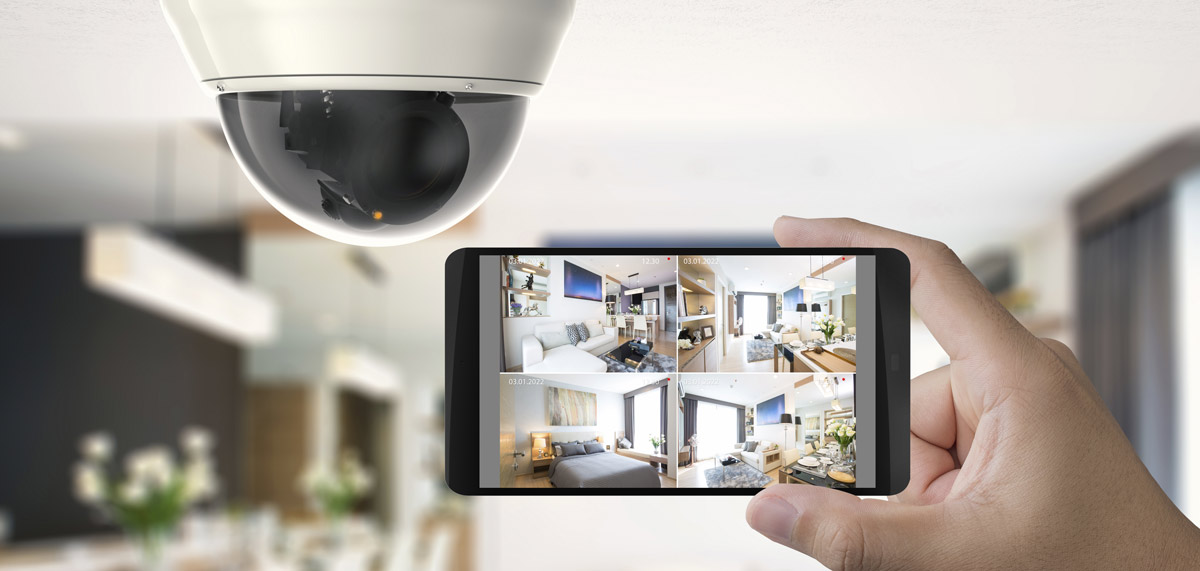Published: 12/21/2019
Every year there are 2.2 million burglaries in the United States, meaning one burglary takes place every fifteen seconds. As a result, 17% of homes in the United States have a home security system in place.
Due to recent advancements in home security, choosing a security camera system for your home can be overwhelming. A security system is full of endless options and customizations. After all, why shouldn’t there be? It would be hard to believe that a four-story apartment building in South Carolina would require the same security system and features as a ranch-style home in Texas.
For the most part, today’s security systems can be purchased as a DIY kit or through a company that will both install and monitor your cameras. Now when we say “DIY kit” that doesn’t necessarily mean they are simple enough for anyone to install. More so that they can be purchased as components from various manufacturers and monitored via a third-party app or service. Though, some cameras and systems are simple enough for the Average Joe to install.
In terms of the security system itself, systems can be wired, wireless, or wire-free. Though the nomenclature seems straightforward, these commonly are a source of confusion. In this post, we dive into the differences of each system as well as the advantages and disadvantages of each type.
As you do your research on home security systems, there are a few features and considerations you will want to keep in mind depending on your home’s layout and your unique security needs.
In this blog post, we will walk you through what you will want to look for, including:
Security system (wiring) types
Security camera types
Housing types
Camera features
Security System Types:
Wired vs Wireless vs Wire-Free
WIRED Security systems
Traditional wired cameras require cables for power and video transmission. Wired cameras can be powered by a separate DC power cord alongside the video or combined on POE (Power Over Ethernet), utilizing the same cable as the video transmission.
Wired systems are ideal for large properties that wireless systems will not cover, new construction or remodel projects where wires can be easily run, buildings with easy access to wire run paths such as drop ceilings, attics, or exterior soffit.
WIRELESS security systems
We frequently find that the term “wireless” isn’t as intuitive as it may seem. Wireless cameras still require a cable to receive power. The use of the term “wireless” simply refers to the lack of a cable necessary for video transmission. Wireless cameras are generally easier to install than traditional wired cameras because power outlets or junctions are often located close by.
Wireless systems are ideal for temporary living, smaller properties, or finished properties without easy access for wire concealments such as attics and DIY’ers.
WIRE-FREE (BATTERY POWERED) security systems
Wire-free security cameras are truly wireless cameras. Just like a wireless camera, they don’t require cables for video transmission, and additionally, they don’t require a cord to receive power. This makes them easy to install but it does come with a few drawbacks such as the need for battery charging or replacement.
Wire-free systems are ideal for temporary living, smaller properties, and homes without a budget for wire concealment or no close access to power.
Camera Types:
Fixed vs 360º vs PTZ
fixed security cameras
A fixed security camera is the simplest camera available. While a basic camera may seem less advantageous, there are some benefits. For one, unlike 360º and PTZ cameras, a fixed camera has few moving parts and therefore less that can go wrong. And, because the direction of the camera isn’t adjustable, it is always pointing in the desired direction.
360º security Cameras
360º cameras consist of multiple cameras placed in a single housing unit (typically a dome camera). 360º cameras don't provide the desired benefits and often it is difficult to find an ideal location to place the camera without an unobstructed view.
PTZ security Cameras
PTZ or pan/tilt/zoom cameras get their name from the vast array movement options of the camera. PTZ cameras can quickly and easily, remotely adjust, providing you with a detailed view of what’s happening inside and outside your home. One of the main benefits of a PTZ camera is that they make it possible to monitor a large space with fewer cameras.
Security Camera Housing Types
Dome cameras
As their name suggests, dome cameras have a dome-shaped housing and are widely used both inside and outside homes and commercial buildings.
The main advantage of using a dome camera is that it is often difficult to determine which way the camera is facing. Plus, dome cameras are more durable and resistant to vandalism than other security camera housing types.
Amcrest UltraHD Outdoor 4-Megapixel PoE Vandal Dome IP Security Camera - MicroSD Storage, IP67 Weatherproof, IK10 Vandal-Proof, 4MP (2688 TVL), IP4M-1028E (White)
bullet cameras
Unlike a dome camera, bullet cameras are shaped more like a rifle. Bullet cameras are often placed outside of a home or building pointing in a single direction where the direction and orientation of the camera are very obvious.
The three main advantages of using a bullet camera are their versatility in placement, they are easy to keep clean, and they tend to produce a clearer image due to their ability to reflect light.
Amcrest UltraHD 4K (8MP) Outdoor Bullet POE IP Camera, 3840x2160, 131ft NightVision, 2.8mm Lens, IP67 Weatherproof, MicroSD Recording, Black (IP8M-2496EB)
Security Camera Features
Resolution
for those looking to purchase a new security camera. And as you can imagine, the image resolution options are better than ever. You can find cameras on the market with up to 4k resolution.
There are a few downsides to a higher-resolution camera, such as the higher the resolution, the more space is required to store and manipulate the images produced. Luckily, it generally isn’t too expensive to increase storage availability. The other potential drawback is that higher resolution cameras typically don’t respond as well to low-light situations.
Night vision
Clear night vision is one of the most important features of an outdoor security camera. Selecting a camera with infrared (IR) technology will deliver the best and brightest image in low light. For the best visibility, we recommend you select a camera with night visibility of up to 100-feet or more.
mobile remote control
Depending on how you plan on monitoring your cameras, a mobile app can provide you with a live feed directly on your mobile device.
For the most part, there are two types of surveillance apps available, proprietary apps, and third-party apps. A proprietary app will only work with the company's IP security cameras at no extra cost, whereas third-party apps are compatible with different camera brands and will most likely cost you a monthly fee to use. If you plan on using a third-party app, make sure it is compatible with the cameras you plan on purchasing.
Tamper Detection
Purchasing a camera with tamper detection capabilities lets you receive an email or SMS notification whenever the camera is vandalized or physically attacked, the view becomes obscured, or if the power line to the camera is cut.
home burglary Statistics
Each year there are 2.2 million burglaries in the United States, meaning one burglary occurs every fifteen seconds.
On average, the monetary loss from a burglary in the US is $2,000, with the common stolen items including stolen cash, jewelry, guns, drugs, and small electronics.
Break-ins are 6% more likely to occur during the day between 6am and 6pm.
Homes without a security system in place are 300% more likely to be burglarized.
Burglary rates increase an average of 11% over the summer months as a result of warmer temperatures. In some cities the increase can be as high as 35%.

















